Abstract
Today, marketing is a powerful tool to attract and influence the user, providing directional communication anywhere at any time. This article raised the topic of the importance of mobile applications in an increasingly digitalized economy. We examined the types of mobile applications and the most popular types. Mobile applications are one of the types of entrepreneurial activities, it should generate income. This fact is well traced, which led to the direction of this work, which examines in detail the economic model of a mobile application monetization, the features of its promotion in the technology market. The features of the model are described and examples of calculations are given. Additionally, investigated the user activity statistics of the application. Particular attention is paid to the F-Growth parameter, which allows assessing the readiness of a mobile application for active promotion. Monetization is the most important aspect in the work of the project in any field of activity, since it is it that allows you to generate income, and marketing is a tool for generating income. It is worth noting that the traditional methods of business monetization are being replaced by new methods, for example, partnerships, advertising, etc. That is why it is important to be able to quickly respond to changes in the method of monetization, which are primarily aimed at optimizing costs, reducing costs and increasing margins.
Keywords: Monetizationpromotionapplicationsmobile
Introduction
The development of information and communication technologies (ICT) has expanded the possibilities of using the Internet and the ways of access to it. On the one hand, this spurred the development of trade, creating additional opportunities for sellers to communicate with customers and ways to influence them, and on the other hand, it created easier ways for consumers to receive information about the product and quickly make purchases without leaving home.
The main quality of the Internet – the ability to quickly transmit, receive and store information – with the development of ICT has been supplemented by the possibility of reducing the costs of doing business and expanding the consumer audience. Moreover, the development of Internet technologies now reduces the need to attract investors in the early stages of implementing ideas or launching a business project. If ten years ago the launch of any project of any significance was not conceivable without creating a website – one of the easiest ways to attract the attention of an audience, now mobile applications are becoming one of the most promising ways to attract the attention of an audience.
Today, the market is flooded with this type of software products, due to their compactness, speed of installation and use, and most importantly – the presence of mobile devices in 66 % of the world's population (Carmigniani et al., 2011; Gritsanov & Abushenko, 2003; Mago, 2017). Mobile applications can act in different qualities: both in the form of a game, and in the form of a functional program, as well as in the form of a trading tool. However, the promotion of the created electronic product, ensuring its uninterrupted operation, replication is associated with costs, which leads to the need for their evaluation, as well as estimates of future income. Application revenue is generated using different monetization methods.
Mobile applications mean software products designed specifically for mobile devices (smartphones, tablets, multimedia consoles, and other “smart” devices) that help solve various application problems: from electronic messaging, entertainment and navigation to performing highly specialized functions (Hofacker, De Ruyter, Lurie, Manchanda, & Donaldson, 2016; Klopfer & Sheldon, 2010).
Mobile applications have become one of the main trends in the development of information technology. If in 2008 (the year of the launch of the first major online mobile application store App Store), the mobile application market was just emerging, but by now it has entered a phase of active growth.
Experts divide the mobile application market into the following segments:
Content applications (such popular activities as listening to music, watching various films, clips and photos, as well as reading digital books).
Business applications (currently quite narrow segment of mobile applications that allow to solve various professional tasks, including traditional office applications).
Mobile games (currently the most popular type of mobile entertainment).
Mobile social networks (applications that allow users to exchange text messages, photos and other content).
The rapid growth in the number of mobile devices (and accordingly the increase in the number of their active users), the increase in their productivity and multimedia capabilities, as well as the development of data networks (digital distribution channels of mobile applications) have made the mobile application market very attractive for investors (Nee, Ong, Chryssolouris, & Mourtzis, 2012; Ong & Nee, 2013). All this makes the development of mobile applications more and more relevant. Moreover, this area is promising both in the global market and in Russia.
Important events in the mobile application market in the past 2013 Analysts called the growth of revenue from mobile applications in the BRIC countries, as well as the rapid rise in popularity of games for iOS and Android, which is why in the 3rd quarter of 2013 expenses of application stores users for games were 3 times higher than the amount that was spent on content for game consoles for the same period. In addition, mobile Internet banking and music applications were in the trends of the year: the first in 2013 shook 55 % more often, the latter brought profit 77 % more.
As a trend, we can note the rapid and steady increase in the number of mobile applications downloads in Russia. So, in the world ranking by the number of downloads from the App Store, our country takes 5th place, second only to the United States, China, Japan and the UK (4th place on downloads from Google Play). At the same time, Russians do not spend much money on mobile applications: in terms of revenue from downloaded applications, Russia occupies only 9th place in the world (and according to Google Play, it is not in the top ten countries at all).
Since September 2017, based on an analysis of analysts from Sensor Tower, more than 13 million augmented reality applications have been installed among iPhone and iPad users. The number of downloads from September 2017 to March 2018 is presented in figure

Games came in first place in popularity; they occupy about 50 % of downloads. Utilities occupy about 14 % of downloads, are in second place. The third place is occupied by entertainment, they were downloaded by 12 % of the total number of downloads. The fourth place in the rating of downloads is style, it takes 11 %. Photos and videos took fifth place, they have 6 % of downloads. Education has only 4 %, this is an underdeveloped area. The number of downloaded applications is shown in figure

Problem Statement
Developing a quality mobile application is only half the battle. Competent market promotion is also necessary in order for users to find and distinguish exactly the product we need among thousands of similar applications, download and install it on their devices, and also regularly use it. And this is not a trivial task, since the competition in the mobile application market is very high.
Research Questions
Today, marketing is a powerful tool to attract and influence the user, providing directional communication anywhere at any time (Rauschnabel, Rossmann, & Dieck, 2017). This article raised the topic of the importance of mobile applications in an increasingly digitalized economy. We examined the types of mobile applications and the most popular types. Given that mobile applications are one of the types of entrepreneurial activities, it should generate income. This fact is well traced, which led to the direction of this work, which examines in detail the economic model of a mobile application monetization, the features of its promotion in the technology market. The features of the model are described and examples of calculations are given.
Additionally, investigated the user activity statistics of the application. Particular attention is paid to the F-Growth parameter, which allows assessing the readiness of a mobile application for active promotion. Monetization is the most important aspect in the work of the project in any field of activity, since it is it that allows you to generate income, and marketing is a tool for generating income.
Purpose of the Study
This study is aimed at conducting marketing activities based on virality and retention indicators for the freemium model (derived from the words Free – free and Premium – special) for open digital markets.
Research Methods
One of the most obvious and effective ways to promote applications is through reviews on various specialized resources (Schrier, 2006; Zyda, 2005). The following Russian-language network resources can be cited as examples: iPhones.ru, iGuides.ru, PlanetiPhone.ru, AppleInsider.ru (for the iOS platform), Droider.ru (for the Android platform). Such resources allow you to publish small reviews (articles) in which you should describe all the advantages of the application, its differences from competitors. At the same time, misleading users (indicating inaccurate information) regarding the application’s functionality is unacceptable, since such a fraud will be quickly revealed by the users themselves, who will soon publish their negative reviews, making such an application “outcast”, depriving it of any chance of commercial success. It is highly advisable to accompany the description of the application with screen images (screenshots) and, if possible, videos.
In addition, you can organize the placement of advertising materials on popular thematic electronic platforms, taking into account the specifics of the application itself. So, for example, if the application is a game racing simulator, then it is logical to place its advertising on resources aimed at car enthusiasts. Thus, it is possible to achieve increased impact on the target audience.
Another effective channel for promoting the application are social networks and specialized forums / blogs (for example, such well-known resources as w3bsit3-dns.com, habrahabr.ru). Such resources allow live communication with users, which can have a very positive effect in terms of promoting the application, but, of course, is a rather laborious affair.
Do not neglect the creation of the "official page" of the application on the site of the developer (publisher). Such a resource, completely controlled by the developer, will allow to provide comprehensive information about the product, its various versions, as well as respond to user requests and publish their reviews. The so-called contextual advertising is actively gaining momentum (the use of other applications as an advertising platform). Such advertising is usually placed in the form of static or animated graphic banners displayed when the application starts.
Successful promotion allows you to attract part of an active user audience, directing its interest to our application. However, the question inevitably arises of the monetization of a mobile application (making a profit). In fact, monetization is the "converter" that allows you to convert user interest into real money income of the developer (publisher). Freemiumis a business model in which monetization occurs through the provision of additional features for a small fee.
The term free application is inaccurate, because even the free version has a price, for example, a user spends time watching an advertisement. However, for convenience, they call the ad-supported application “free”.
The freemium model involves distributing the application in a given market as much as possible, acquiring and maintaining the maximum number of installations. In most cases, about 10 % of attracted users make purchases within the application, which allows to cover the costs of maintaining the application and its free version.
Below are the main features of the Freemium application, which is aimed at the mass market:
Basic function. For her sake, the user installs the application.
Retention of users and their return to the application.
Monetization of the audience.
Increasing virality – attracting new users by existing users.
Virality is a characteristic of content that makes users want to share it. Virality should be thought out even before the application is launched and built into its structure from the very first stages of distribution.
Consider a business strategy focusing on virality. In the IT industry, market leadership is a great advantage. Even if the leadership is engaged thanks to the free version of the product. However, it should be understood that the viral strategy cannot be applied for life. The author Eric Benjamin in his book Freemium Economics demonstrates a model of market saturation (figure

From this we can conclude that the viral strategy will not bear fruit if the market is saturated. This moment is considered the best when you can redirect the application to internal monetization.
To implement the virality strategy, there are currently two popular ways to acquire new players in a mobile application:
General recommendations are an open viral mechanism in which the user publishes invitations on the Internet or social networks that are addressed to many people.
Personal recommendations are personal invitations from existing users that are sent via personal messages, SMS, email and other communication channels.
Figure

The number of personal recommendations is taken into account, how many recommendations were sent from one user and whether they reached the recipients, and how many users were involved to install the application.
The term users mean visitors who have installed the application. Denote the necessary parameters for subsequent calculations:
Daily users (dU).
New day users (dNU).
Daily active users (dAU) (located in the application for at least 5 minutes).
Total number of users (U).
Total number of recommended users for installation (IU).
The number of users sending installation recommendations per day (active in virality), (DSU) – Daily Spreading Users.
Total number of installation recommendations per day (di).
Average number of recommendations for installation on the sender (AiPSU) – Average Invintation.
Average number of recommendations for installation per user (AiPU).
Number of recommended users to install per day (dIU) – Daily Invited Users.
The ratio of the number of those who completed the installation on the recommendation to the number of recommendations sent (conversion percentage) (IPi).
K-Factor is an average metric indicating the number of users in the application inviting other users (Mantymaki & Salo, 2016), in other words, these are the degrees of attractiveness for implementing recommendations. Denote K-Factor = KF. It is necessary to calculate it as the ratio of users who installed the application through the viral method to active users of this application in one period (Osipov, Prasikova, & Volinsky, 2015). The duration of the viral cycle is difficult to predict and given the short lead times for installation recommendations, sending recommendations and installing the application takes place in one day. For calculation, the base can be the parameters: dNU, dU, dAU, as well as data of the most involved users. We introduce the local K-Factor. Denote the local K-Factor = KFl:
КFl= dIU / dAU. (1)
K-Factor is calculated as the number of recommendations for installation from each user, multiplied by the percentage of conversion of each recommendation to users (Pluzhnik & Nikulchev, 2015). For example, 6 recommendations for installation were sent, and the conversion of installing the application on the recommendation of 22 %. In this case, KF = 6 * 0.22 = 1.3. It is worth noting that the averaged K-Factor without taking into account time is denoted by the global K-factor.
Denote global K-Factor = КFg:
КFg= AiPU × IPi. (2)
Here, invited users are among the recommendations for installation:
IPi=IU / i. (3)
The average number of recommendations for a user installation:
AiPU=i / U, (4)
where i is the total number of installation recommendations, U is the total number of users.
The dynamics of K-Factor changes shows how users react to disabling or introducing new viral mechanics and how well they are perceived as a whole (figure

Also, for analysts they operate with a local K-factor, which is calculated within one day – (Daily) dK-Factor. dK-Factor (change in the degree of attractiveness) is calculated on the basis of dAU and is considered an important parameter since it is oriented towards when building further viral analytics and forecasts.
Undoubtedly, high user loyalty to the application involves them in monetization and virality (Osipov et al., 2015). All three parameters complement each other. It is important that the main task of the application satisfy the user as much as possible. Then the mechanics of retention and virality will work in favor of growth.
Consider the application growth formula. We calculate the coefficient of own growth of the audience of the application (F-growth). Denote F-growth = Fg:
Fg= КF + KR, (5)
K-Retention is a number of users withheld. Denote K-Retention = KR. The formula for calculating: KR = Number of users logging in on day N / Number of users who installed the application N days ago * 100 %. Thus, the growth formula is the sum in the degree of attractiveness and retention of users. Altogether, this speaks of the degree of loyalty and customer focus.
With a rational construction of the marketing strategy of the application, it is reasonable in the process of introducing it to the market to build the mechanics associated with virality and retention on small volumes of installations. After analyzing the statistics, having reached a positive F-growth, begin active procurement of paid installations with increasing volume (Seufert, 2015).
In addition, I would like to briefly consider the remaining business models, the monetization of mobile applications includes:
Premium. The traditional monetization model – the user buys the application before downloading, gaining access to all functions. Typically, the cost of a mobile application varies from $0.5 to $10 (or the equivalent in another currency). This model is most suitable for large projects from well-known developers (for which users are immediately ready to pay money without prior testing). It should be noted that at present the number of applications sold under such a scheme is steadily decreasing.
Free-to-Play. Monetization model of gaming mobile applications. It does not require mandatory cash payments for using the game. However, there are numerous in-game purchases that allow you to get certain advantages in the game (for example, the purchase of additional weapons, experience points, the introduction of a virtual in-game currency, etc.). Thus, this model is a way to lure players who do not want to spend their time passing the game and who want to get game advantages in a faster way. Often used by publishers of massively multiplayer online role-playing games.
Internal advertising. The model provides for free download and installation of the application. But in the process of running such an application, the user is displayed mandatory advertising banners. In this case, the developers receive income from the mobile advertising network (for clicks, i.e. users who are interested and clicked on the banner to go to the advertiser's page). Often, for a fee, it is possible to disable annoying ads (purchase a premium version). The growing monetization model is well suited for projects with a fairly large user audience. In addition, a number of developers and publishers use combined monetization models of their mobile applications (sometimes combining all four of the considered models).
Findings
In general, there is a clear tendency to reduce the use of the traditional monetization model of premium applications (especially in the most profitable segment of mobile games). In conditions of fierce competition from mobile application providers, users are in no hurry to immediately pay a certain amount of money for the opportunity to launch an application unknown to them (with the exception of well-known projects from well-known manufacturers). Many people prefer to try out the application (by downloading and installing the free version) and continue to make a purchasing decision.
In this regard, most mobile applications become free or shareware (for their installation and launch, subject to certain restrictions, you do not have to pay anything). A growing number of developers and publishers are betting on monetization through internal advertising (as an additional or even main source of income). In the mobile games segment, in-game sales generate an increasing share of revenue.
Conclusion
With the development of the mobile applications market, the models existing for the monetization of business that existed in the 20th century significantly varied. In the context of growing users of smartphones and tablets, promotion of applications for them becomes relevant. Now, to use an electronic product, you don’t have to pay for it. Instead of financial costs, the consumer will be offered to spend time watching a commercial or fill out a subscription to a newsletter from a mobile application manufacturer about the shares of its partners.
However, it’s not enough just to promote the programs, you still need to properly monetize them according to the chosen business model, as well as constantly attract and retain interested users. These trends allow us to talk about significant differences between the mobile application market and the markets for tangible goods and services, which indicates the need for its detailed study and formulation of the principles of functioning and regulation. A significant role in monetization is played by partnerships, which, among other things, allow you to receive income for the transferred or received user. The least expensive way to monetize is to attract viral traffic, which requires developing a strategy and testing it empirically to identify the most effective one. Without increased engagement, the promotion of mobile applications is very difficult. Downloading the application by the user is only a part of success, therefore it is important to maintain loyalty.
Monetization is largely dependent on the market. Each market has its own characteristics, but nevertheless, the foundation is the same everywhere. It is worth noting that for each case / project there is a unique and most effective method of monetization and most likely it will consist of diversification of strategies to reduce risks. One of the main qualities of any monetization is the competitive advantage that is used for these purposes. Accordingly, the better formulated, realized competitive advantage, the greater the level of monetization. It is worth noting that the traditional methods of business monetization are being replaced by new methods, for example, partnerships, advertising, etc. That is why it is important to be able to quickly respond to changes in the method of monetization, which are primarily aimed at optimizing costs, reducing costs and increasing margins.
References
- Carmigniani, J., Furht, B., Anisetti, M., Ceravolo, P., Damiani, E., & Ivkovic, M. (2011). Augmented reality technologies, systems and applications. Multimedia tools and applications, 51(1), 341-377.
- Gritsanov, A. A., & Abushenko, V. L. (2003). Virtual Reality. Encyclopedia of Sociology, 18, 1312.
- Hofacker, C. F., De Ruyter, K., Lurie, N. H., Manchanda, P., & Donaldson, J. (2016). Gamification and mobile marketing effectiveness. Journal of Interactive Marketing, 34, 25-36.
- Klopfer, E., & Sheldon, J. (2010). Augmenting your own reality: Student authoring of science‐based augmented reality games. New direct. for youth development, 128, 85–94.
- Mago, Z. (2017). New trends of marketing communication based on digital games. European Journal of Science and Theology, 13(6), 171-182.
- Mantymaki, M., & Salo, J. (2016). Teenagers in social virtual worlds: Continuous use and purchasing behavior in Habbo Hotel. Computers in Human Behavior, 27(6), 2088–2097.
- Nee, A. Y., Ong, S. K., Chryssolouris, G., & Mourtzis, D. (2012). Augmented reality applications in design and manufacturing. CIRP annals, 61(2), 657–679.
- Ong, S. K., & Nee, A. Y. C. (2013). Virtual and augmented reality applications in manufacturing. Spitzberg: Springer Sci. & Business Media.
- Osipov, I. V., Prasikova, A. Y., & Volinsky, A. A. (2015). Real time collaborative platform for learning and teaching foreign languages. arXiv preprint arXiv:1501.04155.
- Pluzhnik, E. V., & Nikulchev, E. V. (2015). Virtual laboratories in cloud infrastructure of educational institutions. 2nd Int. Conf. on Emission Electronics (ICEE) (pp. 67–69).
- Rauschnabel, P. A., Rossmann, A., & Dieck, M. C. (2017). An adoption framework for mobile augmented reality games: The case of Pokémon Go. Comput. in Human Behavior, 76, 276–286.
- Schrier, K. (2006). Using augmented reality games to teach 21st century skills. ACM SIGGRAPH 2006 Educators program, 15.
- Seufert, E. B. (2015). Freemium economics: leveraging analytics and user segmentation to drive revenue (The Savvy Manager's Guides). Waltham, MA: Morgan Kaufmann.
- Zyda, M. (2005). From visual simulation to virtual reality to games. Computer, 38(9), 25–32.
Copyright information

This work is licensed under a Creative Commons Attribution-NonCommercial-NoDerivatives 4.0 International License.
About this article
Publication Date
07 December 2020
Article Doi
eBook ISBN
978-1-80296-095-2
Publisher
European Publisher
Volume
96
Print ISBN (optional)
-
Edition Number
1st Edition
Pages
1-833
Subjects
Management, human resources, resource efficiency, investment, infrastructure, research and development
Cite this article as:
Kukartsev, V. V., Tynchenko, V. S., Korpacheva, L. N., Dremin, R. S., Stepanova, E. V., & Bets, Y. S. (2020). Features Of Monetization And Promotion Of Mobile Applications. In A. S. Nechaev, V. I. Bunkovsky, G. M. Beregova, P. A. Lontsikh, & A. S. Bovkun (Eds.), Trends and Innovations in Economic Studies, Science on Baikal Session, vol 96. European Proceedings of Social and Behavioural Sciences (pp. 775-785). European Publisher. https://doi.org/10.15405/epsbs.2020.12.101

